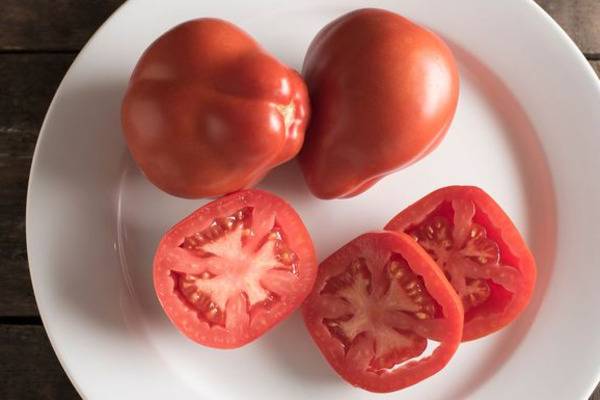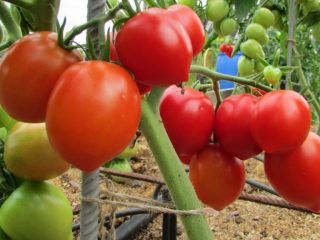Content
Breeders are constantly developing new varieties of tomatoes. Many gardeners love experiments and always get acquainted with new products. But every summer resident has tomatoes that he always plants, year after year. Such favorite and popular tomato varieties include Grushovka.
Description of the variety
The Grushovka tomato of Siberian selection is suitable for growing in open ground, in a greenhouse. The growing season for tomatoes of this variety is 110-115 days. Standard bushes do not grow higher than 0.7 m and do not require pinching. When the fruits ripen, it is advisable to use supports, otherwise the stem may break under the weight of ripe tomatoes.
Tomatoes of the Grushovka variety live up to their name - the raspberry-pink fruits grow pear-shaped as in the photo.
Ripe tomatoes can weigh on average 130-150 g and, according to reviews from summer residents, have a pleasant taste. Tomatoes do not crack, are perfectly stored and transported, and are suitable for processing, canning and fresh consumption.
The main advantages of the Grushovka tomato variety:
- no special conditions are required for growing tomatoes;
- it is characterized by low growth and a fairly strong vertical trunk, therefore it needs garter already during the ripening period;
- the root system is close to the surface, which ensures rapid absorption of water and fertilizers;
- drought-resistant;
- no pinching required;
- resistant to diseases and pests;
- tomatoes tolerate transplantation well.
The Grushovka variety has practically no drawbacks and is characterized by high productivity - approximately 5 kg of tomatoes can be harvested from a bush.
Features of cultivation
To get a good harvest, you need to grow strong seedlings. Therefore, when sowing seeds, you need to pay attention to the soil and the quality of the seed.
Serious producers treat seeds with special disinfectants, antifungals, and growth stimulants. Pre-sowing treatment is written on the packaging or the grains are colored. If it is not possible to buy expensive seeds, then you can buy unprocessed grains and carry out the preparation yourself.
To select hollow seeds, all grains are placed in salted water (a teaspoon of salt is dissolved in half a liter of water). Full seeds settle to the bottom, while empty seeds float on the surface. To disinfect Grushovka seeds, use a 1% solution of potassium permanganate - they are wrapped in a loose cloth and immersed in the solution for 18-20 minutes.
Planting seeds
It is believed that the sowing of tomato seeds of the Grushovka variety is carried out 60-65 days before planting on the site. It is recommended to purchase a special soil mixture for growing seedlings.
- Layers of drainage and soil are poured into the box. To prevent weak seedlings, Grushovka seeds are placed in grooves 2-2.5 cm deep. The seed is covered with earth and the entire surface is slightly moistened.The container is covered with transparent film or glass and placed in a warm place.
- When the first sprouts of Grushovka tomatoes appear, remove the film and place the box in a well-lit place.
- When the seedlings have three leaves, the sprouts can be planted in separate containers. To harden seedlings, you should take them out into the open every day. The period of exposure to fresh air is gradually increased. Immediately before planting, the seedlings should already be outside all day.
The time for planting Grushovka tomatoes in open ground is determined by the air temperature outside. The optimal time is when the soil warms up to 14-17˚ C. It is recommended to place no more than 5-6 bushes per square meter.
When arranging the beds, it is advisable to maintain a distance of 30-40 cm between the holes in the row, and to allocate strips 60-75 cm wide for the row spacing.
Watering and fertilizing tomatoes
The standard tomato variety Grushovka does not require special attention. It is enough to water as the soil dries out. Since the roots of this tomato variety are located close to the surface, it is necessary to avoid excessive watering. Otherwise, the root system of the tomatoes will be exposed. To prevent the soil from drying out quickly, loosen the soil.
Mulching the soil is also a great way to prevent the soil from drying out quickly. In addition, mulch will slow down growth weed. Straw and mown grass are used as mulching material.
Fertilizing
If the soil on the site is not fertile, it is recommended to apply mineral and organic fertilizers.
- 7-10 days after planting, the first fertilizing is carried out. You can use different mixtures. In 10 liters of water, dilute a tablespoon of nitrophoska and half a liter of liquid manure or a tablespoon of “Ideal” factory fertilizer. Half a liter of solution is poured under the Grushovka tomato bush.
- During the flowering period, a solution is used: add 0.5 liters of chicken manure, a tablespoon of superphosphate and a teaspoon of potassium sulfate to 10 liters of water. The mixture is thoroughly stirred and a liter of solution is poured under each bush.
- When Grushovka tomatoes begin to ripen, it is necessary to use fertilizers containing boron, iodine, manganese, and potassium. These elements will ensure high yields of juicy and fleshy Grushovka tomatoes. To prepare the fertilizer, take 10 liters of water, 10 g of boric acid (powdered), 10 ml of iodine, 1.5 liters of ash (well sifted). The mixture is carefully stirred and poured under the bush, one liter at a time.
To accelerate the setting and ripening of tomatoes of the Grushovka variety, foliar feeding is carried out. To do this, dilute 50 g of superphosphate in 10 liters of hot water. The solution should stand for a day and then each bush is sprayed with 10 ml of the composition.
It is better to apply any types of fertilizing in dry weather in the morning or evening. The best option is to combine this procedure with watering the tomatoes. You can alternate different ways of feeding Grushovka tomatoes.
Diseases and preventive measures
The Grushovka tomato variety is considered resistant to many types of diseases. But if signs of the disease appear, you should not hesitate to take action.
Macrosporia blight appears as brown spots on the foliage and trunks of tomatoes. The fungus forms first on the lower leaves and spreads up the plant. Tomatoes become infected especially quickly in conditions of high humidity, especially when alternating rainy and dry weather. On fruits, round brown spots form first around the stalk. Grushovka tomatoes can suffer from the disease at different periods of the growing season. As a preventive measure, it is recommended to avoid placing tomato beds next to potato plantings. To combat the disease, products containing copper (a solution of a suspension of 90% copper oxychloride) are used.
Viral mosaic spreads in the cells of Grushovka tomatoes, destroying chlorophyll. Therefore, the foliage acquires a spotted pattern with streaks of emerald and beige shades. The foliage becomes thinner and collapses, which leads to a decrease in the number and size of tomatoes on the bush. The virus survives well in the ground, and settles in tomatoes of the Grushovka variety thanks to mites and nematodes. There are no means to combat the disease yet. Drastic measures are to remove diseased plants from the site and burn them. As preventive measures, it is necessary to fight disease vectors, collect residues after the harvest and burn them.
Storage rules
Ripe fruits are placed in boxes with the stalks facing up. First, you need to put paper on the bottom of the container.
The boxes should be installed in a cool, darkened room. The optimal storage temperature is 10-13˚ C. Tomatoes retain their pleasant taste for 2-2.5 months.
Both beginning gardeners and experienced farmers working on large areas can grow tomatoes of the Grushovka variety and reap an excellent harvest.













